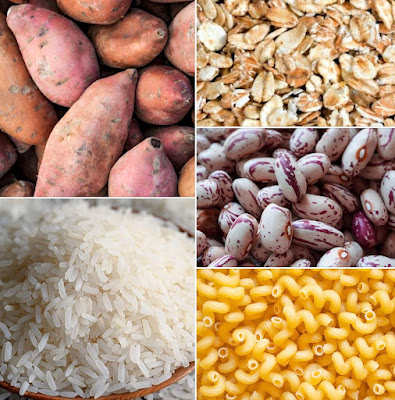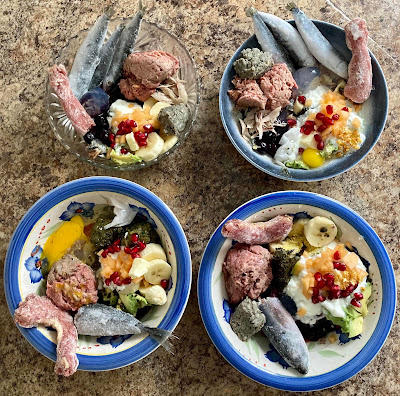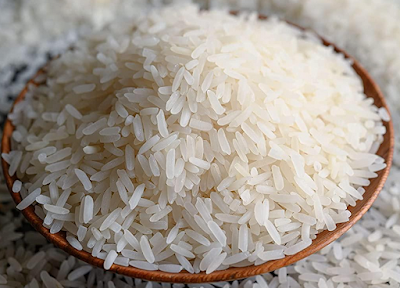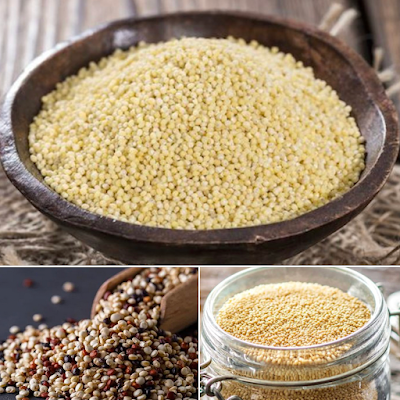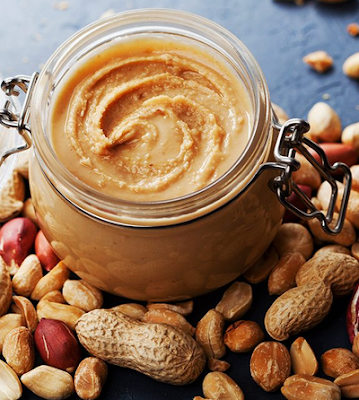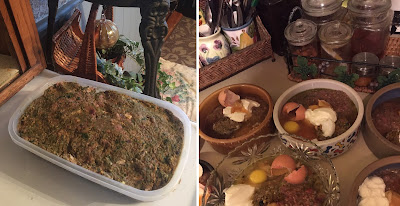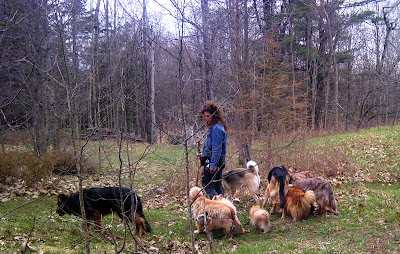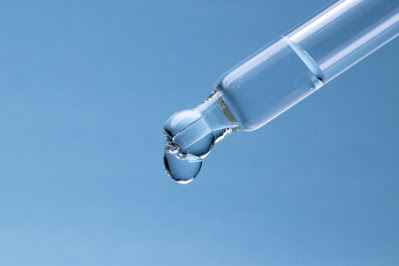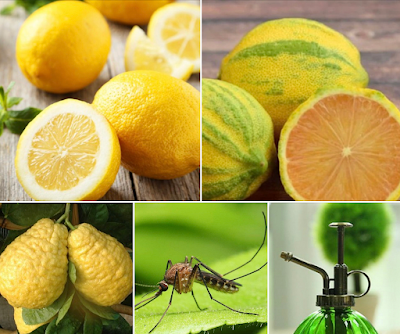Does Your Dog and Cat's Diet Include These Harmful Species Inappropriate Grains, Starchy Seeds, Starchy Root Vegetables, and Beans? What to Avoid and Species Appropriate Alternatives
★11 min read
In this article:
- Species Appropriate Diet for Dogs and Cats
- What Is a Species Appropriate Diet for Dogs and Cats?
- Starchy Carbohydrates are Not Species Appropriate
- Grains, Oats?
- Rice?
- Amaranth, Millet, Quinoa?
- Beans?
- Peanuts, Peanut Butter?
- Starchy Root Vegetables?
- Why and When Did Starchy Carbohydrates Become Popular in Pet Food?
- The Process of Popularization and Consequences
- Prescription Pet Food Diets
- Dry and Canned/Wet Food Diets and Other Diets That Include Starchy Carbohydrates
- AAFCO Approval
- A List of Starchy Carbohydrates Commonly Used In Pet Food
- How Starchy Carbohydrates Harm Your Dog and Cat's Health
- Metabolic Issues
- Carcinogens and Toxins
- Gluten Sensitivity Leading to Autoimmune Issues
- Nutritional Deprivation
- And a Long List of Health Issues and Chronic Disease
- How To Replace Starchy Carbohydrates With Species Appropriate Food
- Greens, Vegetables, Seeds, Herbs and Fruit For Dogs
- Bland Diet For Diarrhea - Don't Use Rice, Do This Instead
- A Basic Species Appropriate Homemade Food Recipe
Are you including any of these starchy carbohydrates (grains including rice and oatmeal, starchy root vegetables, starchy seeds or beans) in your dog and cat's diet?
How and why did these become popular food ingredients for dogs and cats, and why are these harmful? You'll learn how and why in this article. The truth will inspire you to remove these health-harming, species inappropriate ingredients from your dog and cat's diet.
What about rice to treat diarrhea? What should you give your dog instead?
Answers to all of these questions and appropriate alternatives are provided below.
1.0 Species Appropriate Diet For Dogs and Cats
A dog and cat’s species appropriate diet looks very
different than a highly processed pet food diet (kibble, dry food).
1.1 What Is A Species Appropriate Diet For Dogs and Cats?
A species appropriate diet for dogs is a BARF or prey model diet:
Bones and Raw Food (BARF):
65% up to 70% muscle meat (includes fat)
5% liver
5% another secreting organ
10% up to 15% raw edible bone
7% plant material (greens and herbs, seeds, berries)
Prey Model Raw:
70% to 80% muscle meat (includes fat)
5% liver
5% another secreting organ
10% to 15% raw edible bone
2% to 5% feathers or fur
A species appropriate diet for cats is similar to a dog's diet.
However, the breakdown of components is slightly different and does not include greens, seeds and berries.
For an in-depth overview and guide to a species appropriate diet for dogs and cats:
- Go to this article.
1.2 Starchy Carbohydrates are NOT Species Appropriate
Starchy carbohydrates should never be included in a dog or cat's diet.
.1 Grains, Oats?
All types of grains are starchy carbohydrates, including:
- Ancient grains.
- Barley.
- Bulgar.
- Buckwheat.
- Corn.
- Oatmeal, oats (all types).
- Rice (all types, see further below).
- Organic grains.
- Wild harvested grains.
- and all other type of grains.
- Pasta.
- Bread, etc.
All types of grains are species inappropriate, and should never be included in a dog and cat's diet.
NO grains.
.2 Rice?
All types of rice are starchy carbohydrates, this includes:
- White rice.
- Brown rice.
- Wild rice.
- Organic rice.
- Other types of rice.
There
are multiple ways rice causes and contributes to health issues and disease
in dogs and cats. For an in-depth look at these issues:
- Go to this article.
All types of rice are species inappropriate, and should never be included in a dog and cat's diet.
If your dog or cat has diarrhea, don't give your dog and cat rice, choose an appropriate alternative as discussed in this article further below.
NO rice.
.3 Amaranth, Millet and Quinoa
Ancient seeds, specifically starchy carbohydrate seeds, including:
- Amaranth.
- Millet.
- Quinoa.
- All other starchy carbohydrate seeds.
Cooked quinoa is approximate 21% starchy carbohydrate (similar to barley or rice). 83% of the carbohydrates in quinoa are starchy carbs. Cooked amaranth is approximately 19% starchy carbohydrate (similar to quinoa).
All types of starchy seeds are species inappropriate, and should never be included in a dog and cat's diet.
NO amaranth, no millet, no quinoa.
.4 Beans
Beans are starchy carbohydrates, this includes:
- Chickpeas.
- Green peas.
- Lentils.
- Navy bean.
- Soybeans.
- Sprouted beans.
- Other beans, including peanuts (see further below).
There are multiple ways beans cause and contribute to health issues and disease in dogs and cats. For an in-depth look at these issues:
- Go to this article.
Beans are species inappropriate, and should never be included in a dog and cat's diet.
NO beans.
.5 Peanuts and Peanut Butter
Peanuts are a type of bean, they're also a ground nut. Although peanuts aren't a starchy carbohydrate I'm mentioning them in this article as they are popular as a treat, but aren't good for your dog and cat. But there are appropriate alternatives.
All types of peanuts and peanut butter are bad for your dog and cat. This includes:
- All peanuts, including:
- Raw
- Unsalted
- Organic
- etc.
- All peanut butter, including:
- Pure.
- Organic.
There
are multiple ways peanuts (and peanut butter) cause and contribute to health issues and disease
in dogs and cats.
To Learn More:
- An in-depth look at the health issues caused by peanuts and peanut butter.
- Appropriate alternatives to peanut butter.
Go to this article.
Peanuts and peanut butter are species inappropriate, and should never be included in a dog and cat's diet.
NO peanuts.
NO peanut butter.
.6 Starchy Root Vegetables
This includes:
There
are many ways starchy root vegetables cause and contribute to health issues and disease
in dogs and cats. For an in-depth look at these issues:
- Go to this article.
NO potatoes.
NO sweet potatoes.NO yams.
2.0 Why and When Did Starchy Carbohydrates Become Popular in Dog and Cat Food?
2.1 The Process of Popularization and Consequences
During the second world war, governments diverted a vast amount of resources, (including meat), to feed the soldiers on the front lines. While on the home-front, governments encouraged the general public to use soybeans as an alternative to animal protein (which was in short supply). After the war, use of cereal grains and soy continued on an upward spiral of popularity. The general public embraced the new trend in society, which focused on convenience foods (highly processed foods). By the 1950’s the pet food industry was geared-up to join in. Highly processed pet food was heavily marketed to the mainstream population. It was a win-win for the pet food industry.
The use of grains and other starchy carbohydrates in dog and cat food was never for the benefit of a dog and cat's health.
Use of starchy carbohydrates was a result of fresh food shortages during the second world war, which led to the popularization of animal protein substitutes and highly processed food for people and their animals. After the war, the pet food industry saw a too-good-to-be-missed opportunity to enthrall the public in a web of convenience that would see the pet food industry explode into a massive money-making, powerful entity.
Highly processed grains and other starchy carbohydrates provide a cheap source of fillers that increase the volume of a product at little cost to the manufacturer. The resulting pet food products provide poor nutritional value and harm overall health, while supporting the highest possible profit for the pet food manufacturer.
Once the train was in motion there was no stopping it. Highly processed pet food would only grow in popularity as the industry's skill at marketing continued to develop it;s marketing campaigns.
Other members of the pet industry, the veterinarians and the pharmaceutical companies would soon become great allies in the push to market highly processed pet food.
As dogs and cats began to fall ill in increasing numbers (due to the shift from from species appropriate food to highly processed food,) the pharmaceutical industry saw an opportunity for massive profits. More and more drugs initially developed for humans, were migrated over for use on animals. As well, the pharmaceutical companies saw an opportunity to recover losses when drugs were banned for human use due to serious adverse side effects. The pharmaceutical companies lobbied to have the drugs approved for use on pets.
Then the pet food industry began to develop prescription diets.
2.2 Prescription Pet Food Diets For Dogs and Cats
So why does your veterinarian recommend rice, and other starchy carbohydrates for your dog and cat? Why are their prescription diets full of starchy carbohydrates?
Learn why:
- Go to this article.
2.3 Dry and Canned/Wet Food Diet and Other Diets That Include Starchy Carbohydrates
For an in-depth look at dry and canned/wet food diets, and other diets that include starchy carbohydrates - how they harm the health of your dog and cat.
- Go to this article.
2.4 AAFCO Approval of Pet Food
What does this really mean for your dog's health and wellness?
For an in-depth look at AAFCO and why AFFCO approval is meaningless:
- Go to this article.
2.5 A List of Starchy Carbohydrates Commonly Used In Pet Food
Inappropriate, health harming starchy carbohydrates commonly used in pet food products (diets and treats) include:
- Barley (pearled barley etc.)
- Bulgar
- Brewers rice
- Cereal food fines (leftovers from human grade cereal production)
- Chick peas and other beans
- Corn, Corn Bran, Corn Gluten Meal, Corn Germ Meal
- Corn Middlings
- Grain fermentation soluble
- Lentils
- Millet
- Oats or Oatmeal
- Oat Hulls
- Oat Bran
- Quinoa, millet, amaranth
- Rice
- Rice bran
- Rye
- Soy, Soy Flour or Soy (Soybean) Meal
- Wheat Flour, Meal or Middlings (wheat mill run)
- Grain derivatives
- etc.
3.0 How Starchy Carbohydrates Harm your Dog and Cat's Health
3.1 Metabolic Issues
Many of the grains used in commercially manufactured dog and cat kibble are processed grain (cereal) carbohydrates. These are highly digestible, low nutrient, high bulk ingredients which the dog’s digestive system quickly converts to sugar, which in-turn spikes the amount of insulin in the dog and cat's system – over working the pancreas and resulting in a feeling of constant hunger.
Many of the grains used in commercially manufactured dog and cat kibble are processed grain (cereal) carbohydrates. These are highly digestible, low nutrient, high bulk ingredients which the dog’s digestive system quickly converts to sugar, which in-turn spikes the amount of insulin in the dog and cat's system – over working the pancreas and resulting in a feeling of constant hunger.
As the dog
is constantly hungry (due to high-insulin levels) the dog’s human may continue
to feed the dog more of the grain-heavy food which then results in excessive
weight gain – a condition on its own that can cause massive health issues, including:
- Stress
on joints.
- Arthritis.
- Diabetes.
- Inflammation leading to cancer,
etc.
Unfortunately, all too
often a veterinarian will then recommend a low calorie high fibre kibble
(invariably grain based but expensive i.e. Royal Canine or Hill’s Science Diet)
which further exacerbates the problem. The same is true for cats.
3.2 Carcinogens and Toxins
The Proof is In The Numbers
Statistics recorded by veterinary organizations from the 1950's up to present day are very telling.
- The life-span of a companion dog in North America is now half of what it was in the 1950's.
- In the 1950's the average life-span of a golden retriever was 15 to 16 years, today the average is in the range of 8 to12 years.
- In 2005, 50% of older dogs dies from cancer, and the number is on the rise.
The cereal by products used in the manufacturing of many dog foods are derived
from the leftovers of human food processing. It is important to understand that these are remaindered
end of the line substances and as such, they can be full of chemicals.
Aflatoxins
If the grains and grain derivatives aren't human food grade, they can be contaminate with aflatoxins. Aflatoxins cause liver cancer.
Aflatoxins grow on grains beans including peanuts and on tree nuts, (e.g. walnuts, pecans, etc.).
Aflatoxins can also be found in
cottonseed oil, fish meal and peanut oil. Human grade foods are monitored
closely for aflatoxins - if present the raw product (i.e. grain) is not allowed
to be used in human grade food production. There are no such regulations for
animal grade foods so most commercially manufactured animal food (dog, cat,
bird, etc.) will contain aflatoxins.
The majority of corn and soy in North America are grown from Genetically Modified Round-up Ready seeds. GM corn has now been proven to cause the growth
of massive tumours, organ damage and death.
All of the long-term effects of eating GM food is not known. In
addition, large factory farms in North America use a method to process soy that
creates very high levels of photoestrogens and phytates.
- Photoestrogens have been proven to interfere with reproduction and thyroid function;
- Phytates prevent mineral absorption (further exacerbation of poor nutrient intake);
- Phytates interfere with the normal function of enzymes required to digest protein.
Conventional crops are also highly contaminated with heavy use of herbicides, fungicides and pesticides.
3.3 Gluten Hypersensitivity Leading to Autoimmune Issues
The number of dogs and cats living with gluten hypersensitivity is epidemic. One of the
ailments of gluten hypersensitivity is candida (overgrowth of bad bacteria in
the GI Tract). Overgrowth of bad bacteria
is an assault on a dog and cat’s immune system and a common cause of yeast-based
infections. Left untreated or improperly treated, the issue becomes chronic and debilitating. Chronic ear infections, skin infections, urinary tract infections,, chronic diarrhea and more.
3.4 Nutritional Deficiencies
Grains and other starchy carbohydrates are used to increase volumn of products at the lowest
possible cost to the manufacturer. These starchy carbohydrates reduce the bodies ability to absorb nutrients and create serious
gaps in nutrient intake. Compound this with the many other ‘indiscretions’
(e.g. fish meal, low levels of Omega-3 fatty acids, poor source protein)
adopted by pet food manufacturers in the production of dog food and your dog’s
health is in serious trouble.
Did
you know that 10 of the top 10 reasons for a veterinarian visit can be directly
related to inappropriate diet and exposure to ingested, inhaled and topically
absorbed toxins. Highly processed pet food and treats are heavily contaminated with toxins, and bad bacteria.
For an in-depth discussion about toxins and other health harming effects of highly processed pet food (kibble and canned/wet food) and treats go to this article.
3.5 And A Long List of Health Issues and Chronic Disease
Starchy carbohydrates in the diet cause a multitude of health issues and conditions. The following is a partial list of those issues and conditions:
- Acid reflux
- Allergies
- Anxiety
- Arthritis
- Autoimmune issues
- Cancer
- Cardiovascular issues and disease
- Diabetes
- Ear infections
- Edocrine issues
- Eye infections
- Fatty Lipomas
- Gastrointestinal issues and disease
- Kidney issues and disease
- Liver issues and disease
- Intestinal upset
- Metabolic disease
- Thyroid issues and disease
- Pancreatitis
- Parasitic infestations
- Periodontal disease
- Puppy growth issues and developmental conditions
- Seizures
- Skin allergies
- Urinary tract stones
- etc.
5.0 How to Replace Starchy Carbohydrates With Species Appropriate Foods
5.1 Greens, Vegetables, Herbs, Seeds and Fruit For Dogs
Species appropriate greens, herbs, seeds and fruit offer valuable health supporting antioxidants, vitamins and minerals.
Find out how to include these nutrient-rich plant materials in your dog's diet. For:
- A list of appropriate greens, vegetables, fruit, seeds and nuts.
- Preparation tips for optimal nutrient absorption.
- General guidelines on how much to include in the diet.
Go to this article.
Cats do not require, nor do well with greens, vegetables, seeds and fruit, cats are obligate carnivores.
5.2 Bland Diet for Diarrhea - Don't use Rice, Do This Instead
Many veterinarians recommend rice to help treat diarrhea, HOWEVER rice can make diarrhea worse. As well, after reading this article, you now know, rise can cause a multitude of health issues.
So, what should you use instead of rice?
If your dog or cat has diarrhea, a simple species appropriate bland diet an help.
For:
- Guidance on creating a simple species appropriate bland diet can help.
- Typical causes of diarrhea in dos and cats.
- Natural, herbal remedies to help treat diarrhea.
Go to this article.
5.3 Example of a Species Appropriate Homemade Food Recipe
For an example of a species appropriate homemade dog and cat food recipe:
Go to this article.
Holistic Diet, Nutrition, Wellness Services Tailored to Your Individual Dog and Cat
For information about my holistic diet, nutrition, wellness services visit my:
Maintain good health | Address acute and chronic health issues | Pre and post surgery support and recovery
My holistic wellness services are available worldwide via video consultation.
🌎 USA | Canada | UK | Europe | Australia | New Zealand | Asia | South and Central America | Africa | UAE
📱 FaceTime | Facebook | Skype | WhatsApp
Holistic Behavioral Services For Your Dog
For information about my holistic behavioral services visit my:
For dogs of all ages, sizes and breeds
My holistic behavioral services are available locally in-person and worldwide via video session.
🌎 USA | Canada | UK | Europe | Australia | New Zealand | Asia | South and Central America | Africa | UAE
📱 FaceTime | Facebook | Skype | WhatsApp
Affiliations to Companies
✓ None.
✓ I don't sell food or supplements.
✓ I'm not aligned with any companies.
✓ None.
✓ I don't sell food or supplements.
✓ I'm not aligned with any companies.
Article and graphics by Karen Rosenfeld
